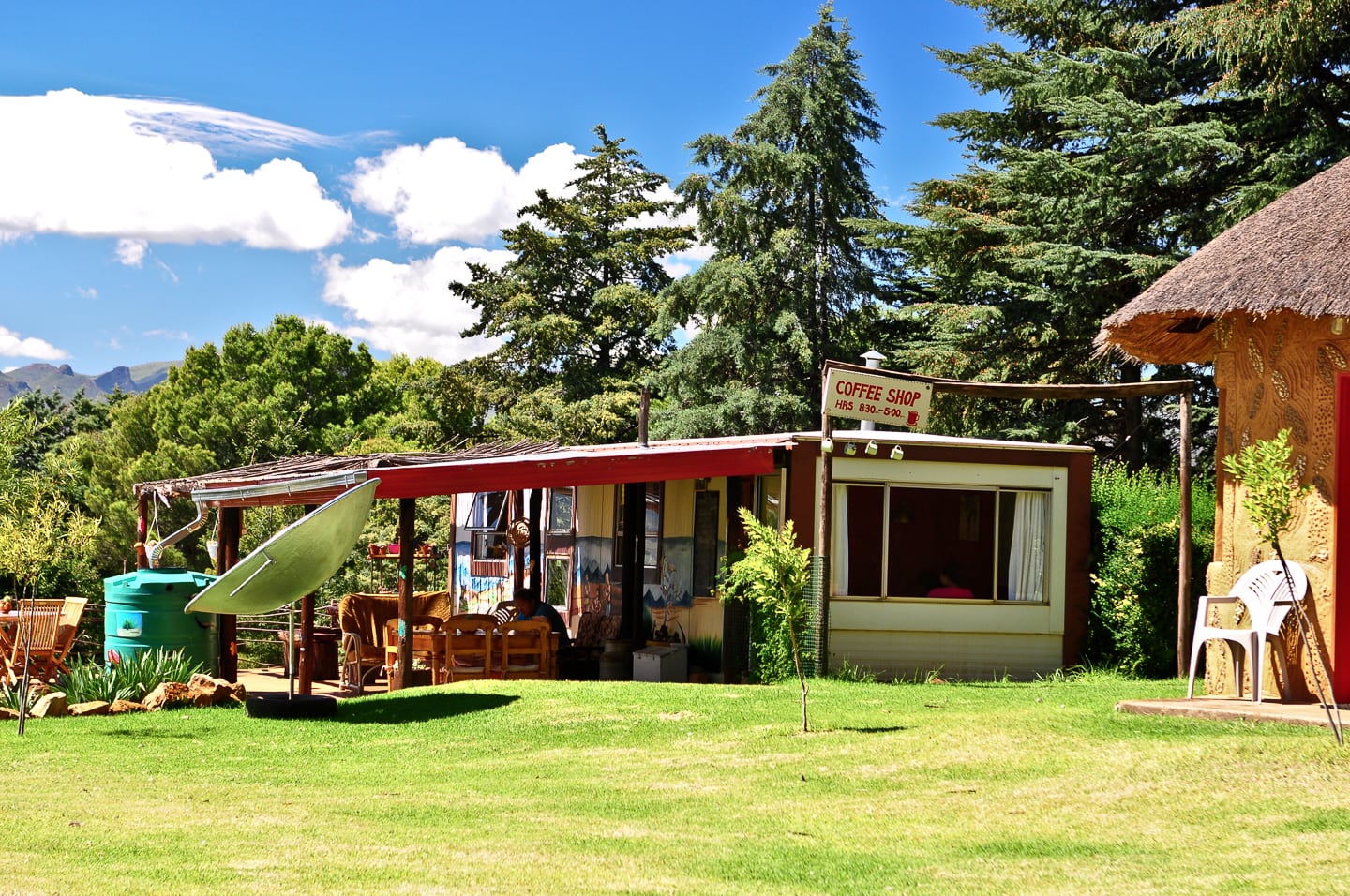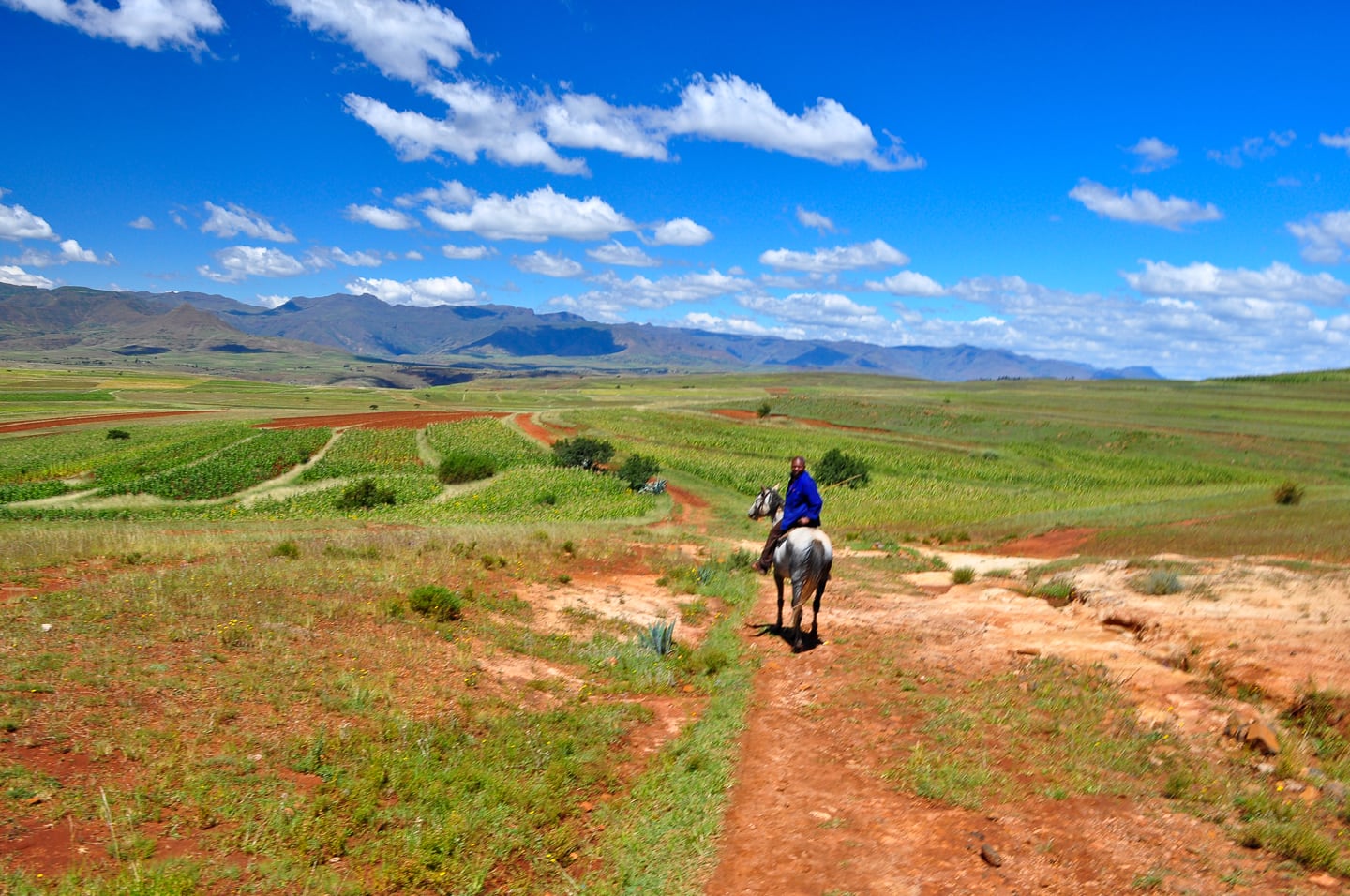I had no idea what to expect before arriving at Malealea Lodge in Lesotho. I knew there would be pony trekking and maybe a bit of hiking. But I was utterly unprepared for just how fabulous and drop dead gorgeous this hidden corner of the planet is.
It’s safe to say that Malealea, Lesotho is now one of my favorite places on earth.

Getting to Malealea Lodge
My research partner, Dow, and I planned to cap off a whirlwind 10-day field visit to Lesotho, South Africa, and Swaziland at Malealea Lodge. Some of our local colleagues in Maseru recommended this place for its rolling prairies and rugged landscape. Malealea did not disappoint.
Though relatively compact, Lesotho is a mountainous little country with limited infrastructure, which means getting anywhere generally takes a bit more time than you might imagine.
Fortunately, the majority of the route from Maseru to Malealea Lodge is quite good and it’s not too difficult getting around Lesotho.
If you’re on a tight budget, you could piece together the journey using a combination of buses and shared minibus taxis (‘taxis‘) or car taxis (‘4+1‘). But because of the short distance from Maseru, we recommend hiring a private car and driver (‘private hire‘), or better yet, renting a car in South Africa beforehand.
The 80 km trip took us around two hours each way by private hire.
If you do chose to drive yourself, remember your TWO red triangles!

Malealea Lodge in Lesotho
Malealea Lodge is tucked away in a quiet valley surrounded by green hills and majestic ridges. A short distance from the property, the ground suddenly falls away into Pitseng Gorge, an incredible gash in the earth perfect for exploring.
The lodge has this to say about their amazing property:

“Lesotho is a world without fences. Breathtaking scenery abounds and every season has unique attractions. Malealea is situated in a remote part of Western Lesotho that is breathtaking in its beauty. This is a chance to experience traditional Basotho life.”

The property, itself, has a variety of lodging options to choose from rondavels and rooms to traditional basotho huts in a clearing and in a nearby grove of trees. There’s also a campground with braai (bbq) facilities.
For current rates and availability, check out the lodge’s website.
And read on for our full pony trekking trip report and tips for your own Malealea adventure.

Intricately decorated Basotho huts and and rooms.

The main building of the Lodge showcases colorful murals of traditional life painted by local artists. It serves as a dining area and function hall.

Nightly, the Lodge also has local singing groups from area schools perform traditional music for guests.

Sunset is a particularly magical time at Malealea Lodge, when the surrounding mountains are illuminated in a broad spectrum of bright colors.

There is a coffee shop onsite as well. It’s a good place to relax and enjoy the breathtaking surroundings while sipping a great cup of coffee.


The lodge grounds are full of wildlife, including numerous species of birds and insects.

A parabolic solar cooker, heating a kettle of water for coffee. Pretty simple yet amazing stuff.
These are becoming more and more common throughout Africa as an inexpensive and sustainable alternative to cooking with wood and coal.

The Malealea Pony Trekking Social Enterprise
Malealea Lodge is known for two things: its majestic surroundings and its pony trekking trips into nearby Pitseng Gorge, led by some of the country’s most highly skilled and experienced riders.

There are a number of different options for pony rides, ranging from a couple of hours to the better part of a day.
Not exactly experienced riders, we opted for a combination pony and hiking trek, initially riding the ponies to the edge of the gorge, then descending down into the gorge on foot.


Dow and I spent the morning riding over the expansive Lesotho veld under blue African skies at an elevation passing one mile (1,600 m). The air was cool and crisp with a light breeze. An absolutely perfect day.


The entire operation is not run by Malealea Lodge, but the result of a partnership with a Pony Trekking Association comprised of local horse-owners in the area.
Basically, Malealea Lodge use their international popularity and name recognition to make bookings for the PTA, and the association takes it from there, organizing which horses and guides take the treks.

Members of the association own their own horses and basic equipment, though Malealea Lodge also buys equipment for the association.
The result is a mutually beneficial partnership in which horse owners not only have access to sustainable livelihoods but also recognize the link between success and strong, healthy horses.
Through this arrangement, the guides are also able to improve their English communication skills (Sesotho is the widest spoken language in Lesotho), in addition to developing other hospitality and business-related skills.

The Malealea Lodge and PTA partnership is an excellent example of how it is indeed very possible to build a strong, mutually-beneficial, and sustainable private sector relationship outside of the traditional aid model.
The idea has been around for a very long time, pre-dating modern foreign aid as we know it, but it has enjoyed something of a renaissance in recent decades and can be observed all over the world in many shapes and sizes.
So yes, for all the naysayers, alternatives are out there and much of the world indeed appears to already be moving in the direction of partnership, self-determination, and sustainability.
Hopefully, it won’t take long for the rest of us to catch up.


Rock art of the ancient San people of Southern Africa on the walls of the gorge.





Exploring Around Malealea on Foot
As you might imagine, the village of Malealea is also a pretty spectacular place to explore on foot, particularly in the morning or early evening. We did not miss any chance to do just that.


Looking back from the road towards the village and Malealea Lodge in the valley below.

We ate all of our meals at the lodge with the exception of one.
The Lodge also has partnerships with locals in the area who cook out of their homes for those who wish to taste and experience traditional Basotho food in a Basotho home.
We met our Basotho host outside the front gates of the lodge and followed him through the neighboring village to his home (above) where he prepared a very tasty traditional meal.
After years spent living and traveling through various parts of Southern, East, and Central Africa, I was surprised to discover that our host and cook was male. It is unusual and even taboo for men to cook in many traditional/rural communities.
It was also fun to learn that he had such a deep passion for cooking and that this was a stepping stone to opening his own small restaurant.

In addition to the meal he prepared for us, we enjoyed chatting with him and his young son in their modest one-room home.
At the end of the evening, in true African style, he asked us to sign his guest ledger, and we did, of course. Which reminds me…Lori and I really need to start one of those for ourselves.



